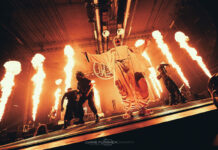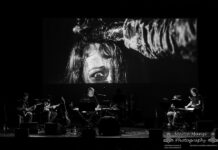On the closing day of the Der Harte Norden exhibition in Berlin, we sat down to talk with the Norwegian black metal historian and collector Finn Håkon Rødland and the manager of the cult Beyond The Gates Festival in Bergen Torgrim Øyre about the exhibition, the history of extreme metal and new music. Read the complete interview here…
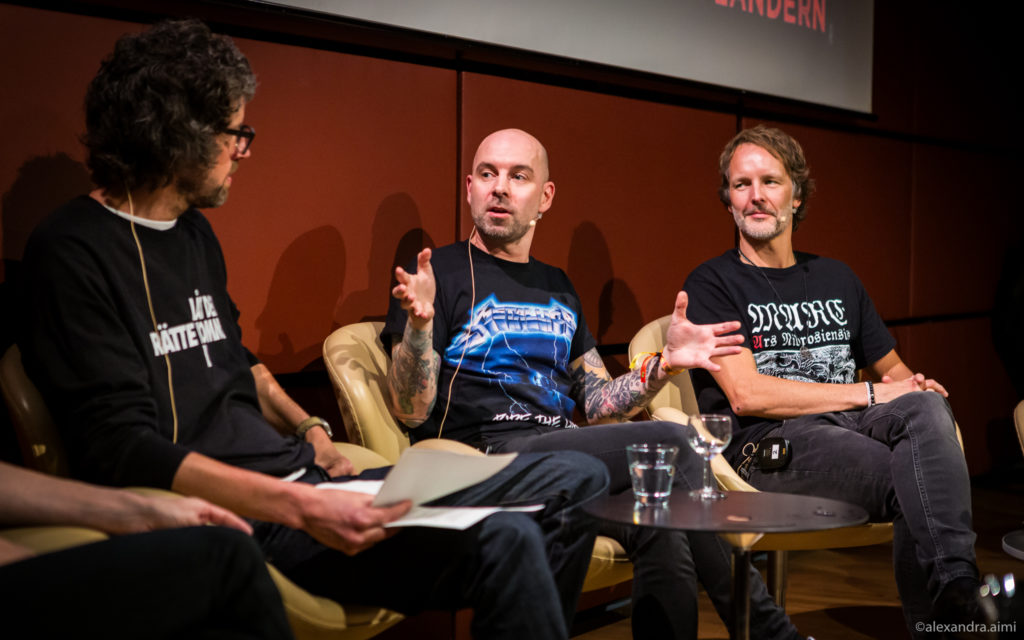
Hi Finn, thank you for your time! I want to talk about the exhibition and your work a little bit. What you do is mindblowing. The items you collect – from what I gathered through your Instagram – are always even the smallest pieces, as well as details that you find are just astonishing. How do you trace those items? Is it hard? What are the obstacles?
Finn: Well, it’s obviously an important fact that I’m friends with a lot of the bands, so that helps as a starting point. I have always been really fascinated by items that bands have used either live or in a recording, so I’ve been so fascinated about even a piece of paper or a photograph, an original one. Relics that have been used on stage and most of these items are impossible to find if you don’t know the guys throughout the years. I have become friends with a lot of the bands and there is a kind of trust relationship being a collector, I think a lot of these guys have learned to appreciate that I take care of those items and put them into a historical context, and I appreciate someone taking the responsibility in doing that.
Most of these items are directly from the band and they can be found also when we have cooperated, for example, doing interviews, I’ve worked on a lot of books, box sets, the historical releases like MAYHEM‘s, I remember specifically when I was working on the “De Mysteriis Dom Sathanas” and I really tried my very best to find out about the portrait photos on the back and I worked on it for a couple of years. I think this was late in the process and then, randomly, this mutual friend of ours, said “I’m pretty convinced that it was actually Snorre that was taking those photos and he should have them.” Then I called Snorre and said, “You know our mutual friend said that you took those photos,” and I’ve been a friend of Snorre for many years but I never thought about asking that and he said, “Yeah yeah, that was me and those negatives might be at my dad’s place, so I’m going to call him and check it out.” Then later that night he called me, “I found the negatives. I’m going to send them to you tomorrow” and he just sent me them and, to me, that was breathtaking because we all have seen the photos of Attila, Hellhammer, and Euronymous. And then overnight, I had the negatives, of the whole shoot, including Varg and Snorre. So just being able to complete it, it’s part of history… and so that’s just one example. It’s a coincidence, that these guys might not give so much thought about it, so when I dig into the history and find details, stuff like this happens.
And it’s amazing, especially if you think about it… it’s been over 30 years since MAYHEM was created, to trace those items that people still have, randomly in their houses is fascinating.
Finn: Yeah, it’s fantastic. You know, one other example… regarding photos, when I was working on the “Cursed in Eternity” I also got the bunch of negatives from Hellhammer’s friend because he was kind of taking care of it for him. And developed the photos and there was a whole shoot, fantastic photo shoot, including Dead, Euronymous, Hellhammer, and Necrobutcher. I saw some of the photos before with Dead and Euronymous, and now I was able to see all of them. It took me actually 3 or 4 years after that to realize that those photos were taken the same night as the gig in Sarpsborg in 1990, The Dawn of the Black Heart concert. So I knew the photoshoot had to happen in that time of space but being able to, in the end, get it verified. It was actually taken before that gig, which also was a fantastic insight to have.
This is so mindblowing, wow.
Finn: Yeah, it is. Again, you have to have somebody who is digging into the past and doing the work, and also never giving up, because if you ask enough people, someone is going to remember at the end of the day and then some doors open, and then you keep finding stuff that has been lost for our heritage. You know, most of these things might have been lost forever if it wasn’t for someone like me, or in this case me, who was able to dig into it and save it and put it into the historical context that it deserves.
This is amazing, the work you did. You’re like a historian, basically just pieced together a part of a vital part of Norwegian/Scandinavian history.
Finn: I think it’s so important, especially from my end, to have done the work that saves, that preserves the information, the historical value, and it has been important for me to not let the bootlegs represent their history. So having “Cursed in Eternity,” “De Mysteriis Dom Sathanas,” and I did “Pure Fucking Armageddon,” we are now starting on “Deathcrush,” and I know I’ve been talking about it for a couple of years but it’s happening. Now I have everything ready – all the files, stuff that has never been heard before. So it’s all there, we will start working now in collaboration with Voices of Wonder again. So they’re exciting things to look forward to.
Amazing! I do want to ask you about the mainstream media. I know you’ve been helping a lot with the documentary series Helvete: Historien om norsk black metal. But I want to ask you about the fictional film called The Lords of Chaos. I would like to know your opinion.
Finn: We actually discussed that yesterday. My take on it is that I love movies and this is a movie. It’s based on some facts but it’s also a bit fictional… this is about MAYHEM and their history but it’s redefined in the American college context and you have to accept that because it’s a movie. There are several mistakes historically and some stuff that I don’t like, but if I’m going to give it a rating, it’s four out of six maybe. It’s not bad, but it’s not a documentary…. then you have to see Helvete, the Norwegian documentary. Then again, I don’t have any credibility as a person, I know I don’t have anything to lose, I’m not trve or whatever you want to call it. I wasn’t part of the environment back in the days when this was going on. So I think sometimes it’s maybe good to have an outside view. It has several mistakes but it’s a decent movie. What I think is my main objective and I talk to people who have reflections about the movie, normally, you do a movie like this when the people involved are dead, most of these guys are in their forties or fifties and have kids, wives, and a life, they are employees that work. So having this movie coming out now is too early, it’s too soon. It should have been made maybe 20-30 years from now. So why couldn’t they show the same kind of respect to these artists as they do in every other genre, you know? For instance, like Elvis Presley, when artists die they make a movie, and they don’t do it when they are in their fifties and have kids. That’s my main objective in the principle of doing it. I think they shouldn’t have done it now. But then again, in 20-30 years, they might not have the interest to do it. My other main objective looking at the movie… I don’t like to splatter, the scenes when Dead committed suicide, the intense deep details of the cutting of flesh, it was speculative, it was gore, it was unnecessary.
It was done for the shock value.
Finn: It was the shock effect and it wasn’t like this. It didn’t happen like that, and Pelle (Per Yngve “Pelle” Ohlin) wasn’t like that either. So the aesthetics of that sequence were totally wrong and I also don’t like the ending, Euronymous cuts his hair and he was supposedly getting his life back on track, that was also totally wrong, he never cut his hair and that wasn’t the plan. So the happy-ending twitch there before he died, was also speculative and totally wrong. So, a couple of issues there. [laughs]. Unnecessary.
Because it was Americanized they needed a happy outcome.
Finn: Yes, exactly. That’s why they needed some happy ending. They needed some hope but there wasn’t any hope.
Interesting because they did collaborate with Norwegians and Swedish I believe on this movie. So technically they could have had consultants. They could have called you, being the main consultant for the Nordics extreme metal, but they didn’t do that.
Finn: It’s a movie and not everything was a fact. It was fictional. But also that irritates me. Why? Why make things up, you know?
I agree, they could have done it with less cheesiness. If it was a European movie, it would have been without a happy ending. I wanted to also ask about this exhibition in particular; how did you approach the Embassy or did the Embassy approach you? How did you guys collaborate?
Finn: At the start, it was Torgrim Øyre who approached me, the Beyond the Gates guys. They told me about this exhibition and in the beginning, it was supposed to be all Norwegian. So then, we were kind of planning to include what I did in Grieghallen for MAYHEM and the exhibition about “De Mysteriis Dom Sathanas” and also include a lot of other stuff. But then, as time moved on, it was evident that the Swedish Embassy and the guys were planning something similar. So, at the end of the day, it was a Nordic concept and then you had to include music from all Nordic countries. So the consequence was that the Norwegian part – my part – was reduced. Then Ika Johannesson came on board, you know the main curator?
Yes, she is also the author of Blood, Fire, Death: The Swedish Metal Story.
Finn: She’s fantastic, so then Ika and Torgrim came to see me in my place and, I showed them some of the stuff I had. We had to define what we wanted to include from Norway and I insisted that we had to show the mace, one of the most important symbolic items for Norwegian black metal. So we had to have that. We included the funeral priest’s costumes from Attila from the Mysteriis Dom Sathanas Tour. I really like that one. So we had that and I suggested including the cock piece from Shagrath, the one that he used in 1998, and I scanned a lot of my concert posters from the ’90s, demo covers because they didn’t want to have the originals, so we made some replicas. DIMMU BORGIR lent some of his stage-worn outfits, and Necrobutcher from MAYHEM contributed with some stuff he used for “Live in Leipzig.” So, you know, a lot of cool stuff. Obviously for me, the Norwegian black metal items here are the most important ones but I, of course, understand that all of the Nordic countries have to be represented and it’s really cool to see. Also, Iceland and Finland and MERCYFUL FATE from Denmark. It’s a good representation and I think they did a really good job.
Yeah, it’s a fantastic job. I’ve seen the whole exhibition, every item, every small piece.
Finn: I especially like the ones where they have all the spikes and all, it’s fantastic.
I really like that everybody contributed something. I also like the setup with the imitated room from the late ’80s… really nice with all the vinyls and books. I was very small when we had this kind of setup at home.
Finn: Yeah, it’s a time capsule. And I think it’s really fantastic that the Nordic Embassies here in Berlin wanted to do this. They did something similar in the Norwegian National Library, a black metal exhibition from March ’till a couple of weeks ago. Having Norwegian black metal and black metal as a part of the official environment, I think it’s an important development. Acknowledgment. You know this is very valuable because it’s the art and – like I said several times – in a couple of hundred years they are going to write history books about Norwegian culture and Norwegian music, it’s not going to be about pop music, it’s going to be a chapter about black metal, about MAYHEM, EMPEROR and everything, so it’s extremely important that our time acknowledges it.
I was amazed how the Nordics acknowledge it because it’s a very controversial topic. For instance, I lived in Poland which is a heavily Catholic-dominated country. Yet, they have a very, very rich black metal scene and the biggest metal export is BEHEMOTH.
Finn: Yeah, and Nergal is struggling in court all the time?
Yes, their shows are being canceled. I’ve seen a lady tear off BEHEMOTH posters on the street.
Finn: The world is turning crazy, it’s getting more polarized, day by day, so it’s not a good development. [laughs]
But still, it’s very positive that Nordics are embracing the culture. Like Viking’s history from centuries ago, let’s hope this will also be a part of history centuries from now.
Finn: Yeah, a couple of years ago, MAYHEM won the one honorary award at the Norwegian Grammy and that’s a fantastic achievement. That is the highest achievement you can get. I think that was fantastic and they deserved it, and I think that was a direct consequence of Helvete, the black metal documentary. Public awareness is increasing, they understand the heritage, they understand that this is a global phenomenon, and this is a band that is known throughout the whole world.
Thank you so much for the insights and your time!
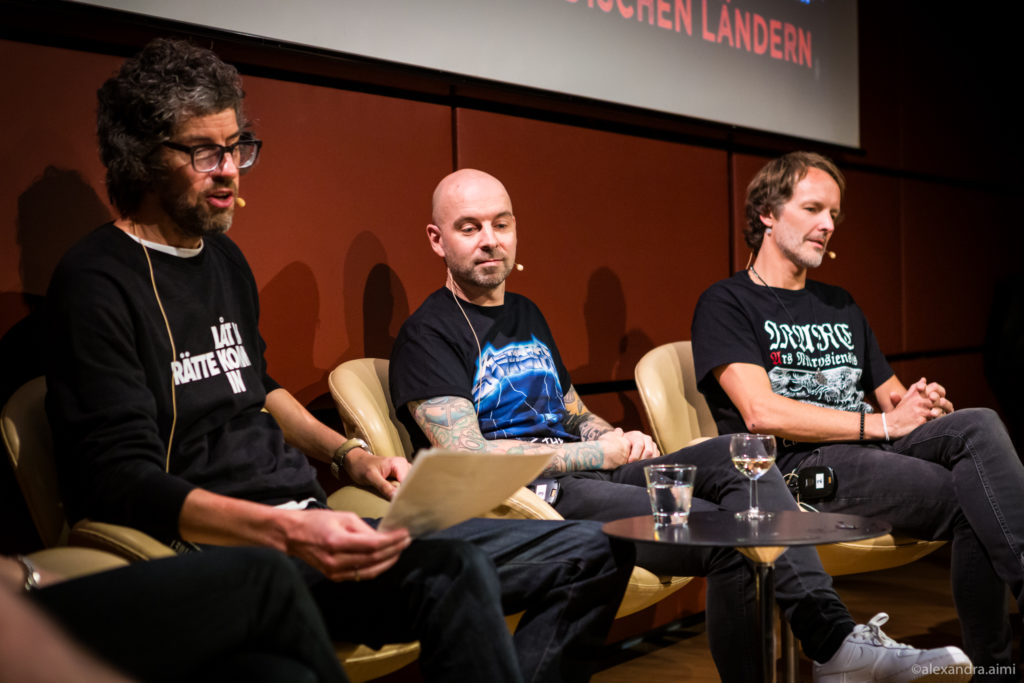
Hi Torgrim, thank you very much for your time again! I would like to ask you a little bit about your job. You are the main person at the Beyond the Gates Festival in Bergen. What does inspire you to do your job?
Torgrim: I think the most interesting part of doing Beyond The Gates is trying to come up with new ideas. New ways to solve problems, new ways to present bands, and new ways to put together the whole program. When you’ve been doing this for like 20-plus years, like we have, there’s only so many bands you can book for a festival. The most interesting part is trying to find new bands that tastemakers talk about, that can be the next, I’m not saying stars but the next big thing. Presentation is a big part of doing Beyond The Gates, a lot of the bands have played there several times. But we’re always trying to find new ways to present them and not repeat ourselves too much. I mean, putting the same show on over or over again, for example, bands like ENSLAVED that played many times, but we still try to do something new with them every time to make it different. And also, find synergies between bands that fit together… one band can have one energy, and another band can have opposite energy and they don’t necessarily fit together. So, it’s always about finding the good balance and the good combinations of bands to make the big picture work together.
Have you particularly listened to new bands yourself, to find some of the hidden gems?
Torgrim: Yeah, I mean like listen to quite a lot of new music, but I also have good partners that I talked to and are active in the scene. It comes with good tips on which bands to check out and stuff like that. Also, I work closely with a guy from Terratur Possessions, and he has his showcases in the club venue during Beyond The Gates. So it’s like trying to partner with people that you trust and have good taste and that you feel you resonate with or have good chemistry with and are on the same page so that we together can make a lineup and program that stands on its own or says something. It’s very amazing.
Did you find a band that you really enjoyed this year? Like made you go, “Okay, this is amazing. I want this for my festival.”
Torgrim: Do you mean the 2023 festival? Yeah, I mean, I would like to actually say that SPIRIT POSSESSION – it was a last-minute addition – they had this very new unique presentation, they had something about them that really took the audience, and it was different. It was energetic and charismatic in a very unique way. I think that having experiences like that is what makes it worthwhile because sometimes you just get blown away by something you didn’t expect at all. So yeah, that’s like that, that makes it really fun and exciting to be doing the festival. I mean, obviously, you know what? KREATOR is a fantastic band, you know they deliver, and so even if they amaze you with their show, you kind of expect that because they’ve been around for like 40 years… so it’s more about seeing new bands and what they are all about and how they conduct themselves and what they can do with a pair of instruments.
That’s pretty cool. The lineup for the next year, is starting to shape well, and especially, I was amazed that you guys called a band from Poland MANBRYNE. The thing is, they never meant to be a touring band, because of their condition, so they concentrated on recording albums only and that’s it. It is so great that you invited them to the festival.
Torgrim: I mean that’s what’s exciting about doing the festival, finding the rare bands that haven’t done the circuit yet, and also I think that they’ve only done a couple of shows locally, so it’s kind of a unique thing. We also try – even with the established bands – to rethink what they do, maybe invite them to do something special, something out of the book, to make the shows stand out, not be just a regular concert but represent an era or whatever just to make a difference.
Amazing. I believe that’s all the questions I can give you because unfortunately, time is running out. Thank you!
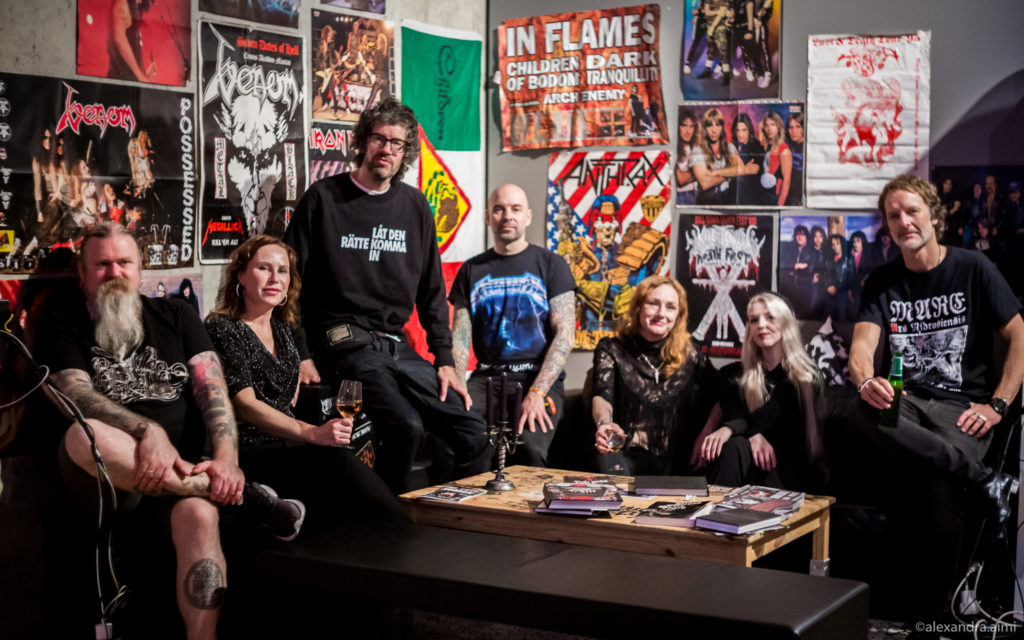
Interview by Alexandra Aim



